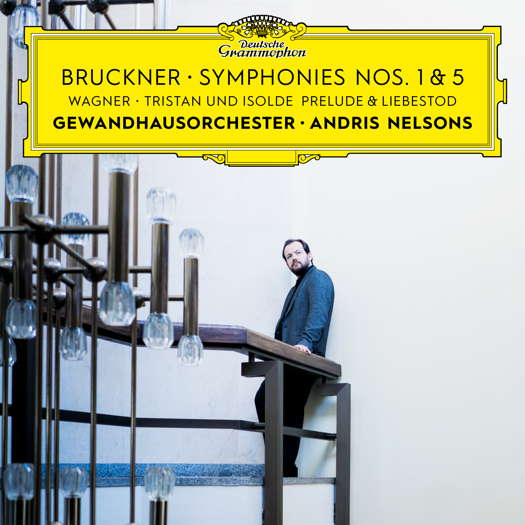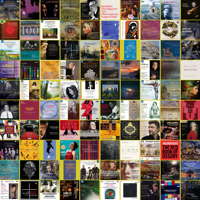
A Spirit of Newfound Confidence
GERALD FENECH listens to the last instalment of Andris Nelsons' Bruckner cycle for Deutsche Gramophon
'Nelsons goes straight to the heart of this quite divinely inspired music with confidence and conviction ...'
'Anton Bruckner (1824-1896) continually transcended boundaries of form, harmony and spiritual content within his works. His first and fifth symphonies, both reaching beyond existing conventions, are remarkable. Inspired both by youthful exuberance and by an existential plight, he composed these works as uncompromisingly and as boldly as only few other works.' So Andris Nelsons sums up the two symphonies featured on this recording.
Bruckner wrote his fifth symphony at a time of extreme financial indigence. He composed it in 1875-76, but continued to make changes to it between then and 1878. Admittedly, Bruckner had recently taken up an unpaid position as lecturer in harmony and counterpoint at Vienna University. One suspects that in writing this symphony, which cost him much effort, he was wanting to prove to himself that he still possessed the necessary abilities in those two disciplines. Maybe that is why the piece is influenced by such greats as J S Bach, Mozart and Beethoven.
As an experienced organist, Bruckner was almost unique among his contemporaries in having an unparalleled command of contrapuntal techniques, and here we find him taking these techniques to their logical extreme and using them to accommodate apparently disparate elements within a rigorous symphonic form.
The symphony's opening is bold and bewildering. Uniquely in his symphonic output, Bruckner here opts for a slow introduction.
Listen — Bruckner: Introduction (Symphony No 5)
(002894862086 CD2 track 1, 0:02-0:54) ℗ 2022 Deutsche Grammophon :
This is followed by a tutti outburst and finally by a chorale that is further removed from the tonic B flat. Only then does the fast main section begin, bringing with it three very different thematic complexes.
Bruckner harks back to the slow introduction at the start of the final movement where he models himself on Beethoven's Ninth, by requoting passages from earlier movements, before the finale, too, gets underway with sonata form and a complex double fugue being overlaid with the greatest conceivable skill.
Listen — Bruckner: Finale (Symphony No 5)
(002894862086 CD2 track 4, 1:40-2:40) ℗ 2022 Deutsche Grammophon :
The two middle movements are based on an identical sequence of notes in D minor which, although different in character, point to the opening of Mozart's Requiem. Bruckner himself described the work 'fantastical'. This is very true, as the symphony culminates in the apotheosis of a radiant chorale, and the cyclical idea of the piece is of the utmost significance to its structure.
The premiere in Graz in 1894, despite many obstacles, including Bruckner's illness, which deprived him of the chance to attend, was a healthy success, but it was only by time that the symphony managed to establish itself in the repertoire of the world's leading orchestras.
For a long time Tristan und Isolde by Richard Wagner's (1813-1883) was regarded as unperformable. The composer hoped that it would be premiered in Rio de Janeiro and then Karlsruhe, while a planned production in Vienna was abandoned after seventy-seven rehearsals. Not until 1865 was his immortal music drama staged in Munich six years after it was completed. Not surprising, as even Wagner had to admit that the opera was immensely difficult to bring off. Writing to Mathilde Wesendonck, with whom the composer was having a non-conformist affair: 'I'm afraid that the opera will be banned. Only a mediocre performance can save me. Truly, good ones will drive people mad.'
The opera does place the most extreme demands on singers and players alike. Central to a work in which almost nothing happens in terms of its plot are inner processes and extreme emotions that demanded a new musical language. Wagner discovered this language in his use of advanced harmonic writing that finds quintessential expression in the 'Tristan' chord that comes at the end of the cellos' hesitant dissonance that can only be resolved with difficulty as a consonance, in that way reaching the very bounds of tonality and influencing other composers far into the future.
Listen — Wagner: Isoldes Liebestod (Tristan und Isolde)
(002894862086 CD1 track 1, 0:01-0:50) ℗ 2022 Deutsche Grammophon :
The Act I Prelude and the last passage that ends the work, the Liebestod (Love-Death), encapsulate the drama as a whole. The Prelude depicts the course of true love from an initial sense of longing to its impassioned outpouring culminating in an expression of supreme ecstasy, while the Liebestod – sung by the dying Isolde over Tristan's corpse – finally brings a sense of relief and redemption. The tension builds inexorably through a series of modulations combined with the composer's sensuous use of blended sonorities culminating in an entrancing B major.
That Bruckner was a great friend and admirer of Wagner is no secret. Indeed, the man from St Florian always enjoyed referring to the great German genius as 'Meister'. So how could he miss not being present for one of Tristan's initial performances? Attending the third one on 19 June 1865 in Munich gave the chance to Bruckner to not only meet Wagner, but also Hans von Bulow, the famous conductor, who also expressed interest in seeing for himself the draft of Bruckner's first symphony. The composer had waited for a long time to broach the symphony, the first he deigned to number. Despite this, Bruckner continued to have lessons in counterpoint with Simon Sechter and orchestration with Otto Kitzler. It was indeed Kitzler who introduced Bruckner to Wagner's music. All of these influences found their way in the first symphony which the composer began in January 1865 in a spirit of newfound confidence. He was at this time already forty years old. The sense of a new departure is already clear from the symphony's opening bars where we find not the 'primeval mists' that were later to become a regular feature of Bruckner's symphonies, but a vigorous march theme that looks forward to Mahler's Sixth.
Listen — Bruckner: Allegro (Symphony No 1)
(002894862086 CD1 track 3, 0:01-0:50) ℗ 2022 Deutsche Grammophon :
There follows a plethora of motifs and ideas – almost too many for a single symphony – but it is the third theme that proves the most arresting, a powerful trombone theme with strings that recalls Wagner's Pilgrim's Chorus from Tannhauser.
Listen — Bruckner: Allegro (Symphony No 1)
(002894862086 CD1 track 3, 3:34-4:00) ℗ 2022 Deutsche Grammophon :
The Adagio impresses by dint of its shifting harmonies and hymn-like melodic writing, the Scherzo by virtue of its unbridled Rossinian drive.
Listen — Bruckner: Scherzo (Symphony No 1)
(002894862086 CD1 track 5, 0:00-0:28) ℗ 2022 Deutsche Grammophon :
The fiery final movement is characterised by the composer's already well-developed contrapuntal abilities. In the early 1890s, when Bruckner had already started work on his Ninth and final symphony, he revised the First with the hope of having it performed by the Vienna Philharmonic, following a promise by Hans Richter to fulfil such an engagement. Nelsons has opted to record this 'Vienna' version which Bruckner himself regarded as definitive. One has to admit that Nelsons is in the company of some huge masters of the baton, both past – Celibidache, Karajan, Klemperer – and present – Thielmann, Barenboim, Chailly. But he acquits himself splendidly with performances full of energy and excitement. Indeed, these renditions brough back memories of when I was enthralled by the Bruckner sound years ago. Nelsons goes straight to the heart of this quite divinely inspired music with confidence and conviction, and his fastidious attention to tempi and dynamics is exemplary. The sound is never bombastic, and he lets the music flow with grace and warmth. Climaxes are superbly judged and the quieter passages are delivered with an approach that borders on the reverential.
Listen — Bruckner: Finale (Symphony No 1)
(002894862086 CD1 track 6, 12:20-13:02) ℗ 2022 Deutsche Grammophon :
This is a glorious conclusion to a cycle that should not be missed. Sonics are first-rate. With this issue Andris Nelsons and his Leipzig players bring to a close their award-winning Bruckner project. Starting in 2017 with the Third Symphony, the cycle has received countless superlatives and garnered the 2017 Edison Klassik Award. Each symphony has been considerately paired with music by Wagner as in this final instalment, thus honouring the relationship that the two composers had during their lifetimes.
Copyright © 19 March 2022
Gerald Fenech,
Gzira, Malta

CD INFORMATION - BRUCKNER: SYMPHONIES 1 & 5




